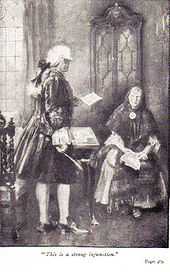Jeanie Deans
| Jeanie Deans | |
|---|---|
| The Heart of Midlothian character | |
 | |
| Created by | Sir Walter Scott |
| Information | |
| Species | Human |
| Gender | Female |
| Occupation | Dairy farmer and housewife |
| Family | Davie Deans (father) |
| Spouse(s) | Reuben Butler (husband) |
| Significant other(s) | The Laird of Dumbiedykes |
| Children | David (son), Reuben (son), Euphemia (daughter) |
| Relatives | Effie (Euphemia) Deans (sister) |
| Religion | Christian, Cameronian |
| Nationality | Scottish |
Jeanie Deans is a fictional character in Sir Walter Scott's novel The Heart of Midlothian. She was one of Scott's most celebrated characters during the 19th century; she was renowned as an example of an honest, upright, sincere, highly religious person. She became so popular that her name was given to ships, railway locomotives, pubs and many other things.
When Jeanie Deans' sister, Effie, is wrongly convicted of murdering her own child, Jeanie travels, partly by foot, all the way to London. Her plan is to appeal to the Queen and receive a pardon for her sister who languishes in prison awaiting execution. She begins walking on her bare feet to save her shoes but puts them on when she passes through towns and villages.[1] By a series of improbable adventures, involving the true abductors of her sister's baby son, she finds George Staunton alias Robertson who had fathered the child. Thereafter she travels on by coach and on reaching London she seeks out the Duke of Argyll who takes her to meet Queen Caroline at Richmond Lodge. She impresses the Queen with her eloquence, spoken in broad Scots.[2] The Queen promises to intercede with King George II, and she ensures that her sister is granted a pardon, on pain of being banished from Scotland for fourteen years. When Jeanie returns to Scotland, she finds that the Duke of Argyll had given her father land to superintend at Rosneath in Argyll.[3] She is also overjoyed to find that her fiancé, Reuben Butler, has been appointed Minister at the neighbouring kirk of Knocktarlitie.[4] She subsequently marries Butler and raises three children named David, Reuben and Euphemia. Jeanie's sister, Effie, pays her a clandestine visit to inform her that she had married her lover who was now Sir George Staunton.[5] Jeanie later learns that her sister's child had not been murdered but was sold to a Highland brigand and was reared to a life of robbery and violence. Sir George is later shot by his own son[6] who escapes to America, where he gets into trouble, joins a tribe of native Americans and is heard of no more. As Lady Staunton, Effie takes her place in London society but eventually retires to a French convent, much to her sister's disappointment at her relinquishing her father's religion.
Sir Walter Scott wrote in his introduction that he had learned the story from an unsigned, undated letter, whose writer had learned it in turn from a Mrs. Helen Lawson Goldie of Dumfries. The original of Jeanie Deans was Helen Walker, whose experience was more austere than the fiction Scott wrote. Helen Walker died in late 1791. Sir Walter Scott erected a monument at Helen Walker's grave in the parish of Irongray, about six miles from Dumfries.

See also
References
- ↑ Sir Walter Scott, The Heart of Midlothian, 1818, (Edinburgh: Nelson [c.1900]), ch. XXVIII, pp. 355 & 359.
- ↑ As above, ch. XXXVII, pp. 489-490.
- ↑ As above, ch. XLII, p. 536. Scott mistakenly refers to Rosneath as an island. It is in fact a peninsula.
- ↑ As above, ch. XLV, p. 579.
- ↑ As above, ch. XVI, p. 588.
- ↑ As above, ch. LII, pp. 664-666.